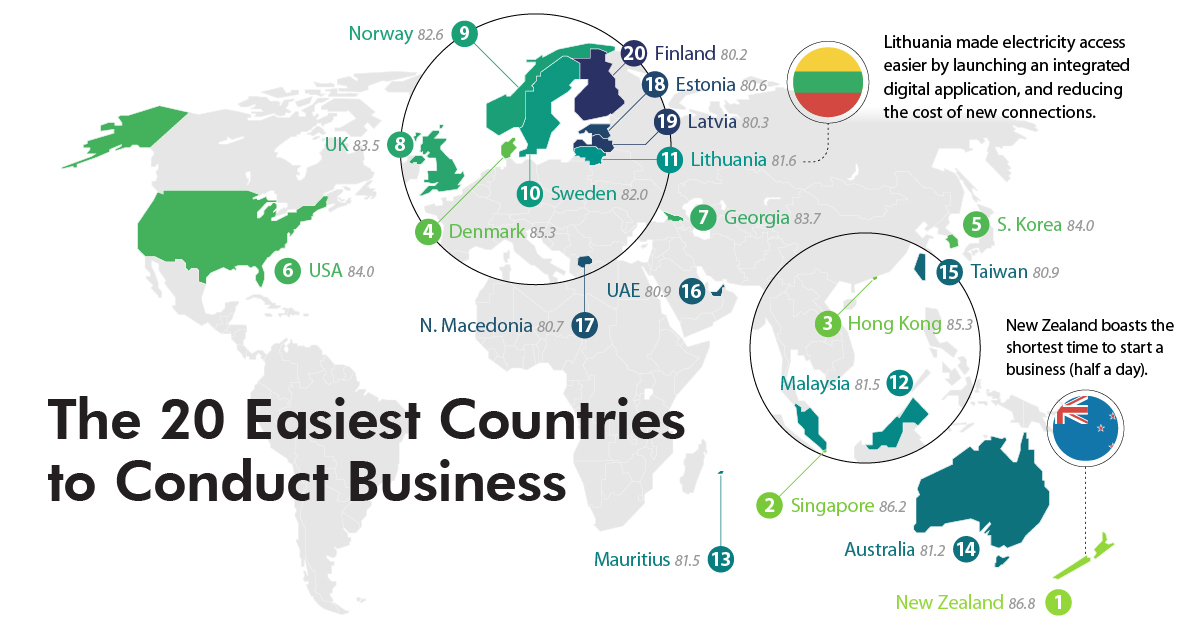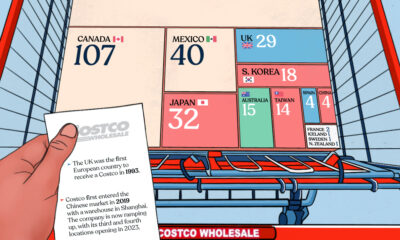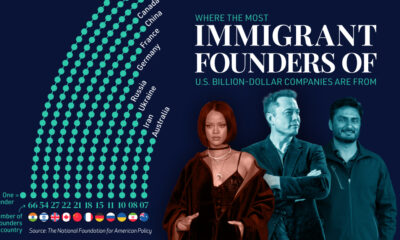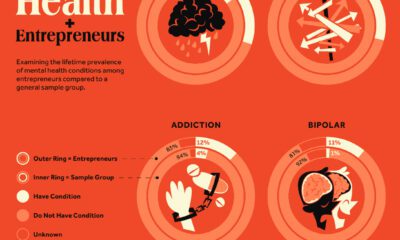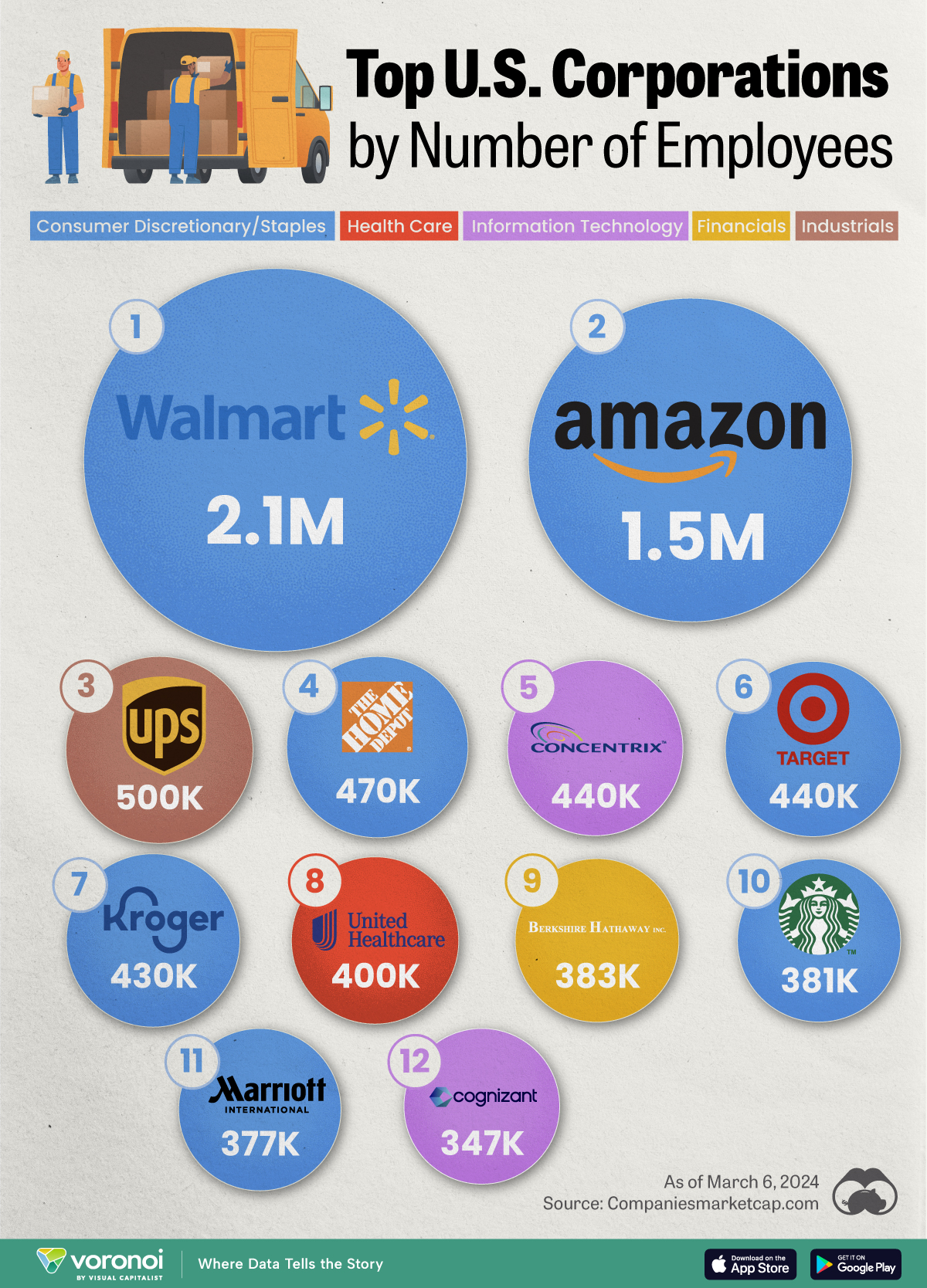Business
Ranked: The 20 Easiest Countries for Doing Business
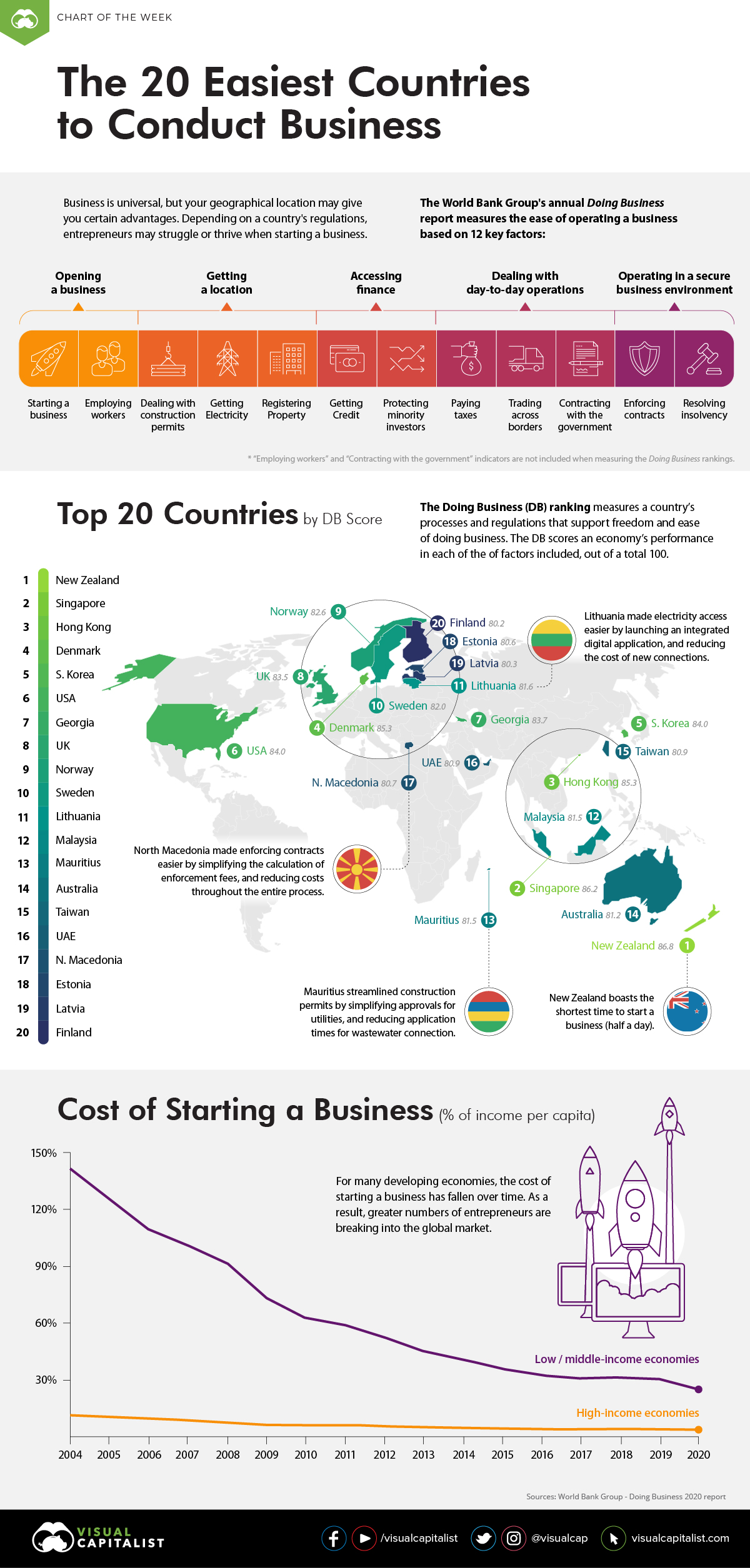
Ranked: The 20 Easiest Countries for Doing Business
Contrary to popular belief, the hardest part about running a business may not be finding customers, it’s getting one started.
Depending on the public policies and application processes of your country, you might struggle or succeed in opening and operating a business.
If you live in New Zealand, for example, you can get a new enterprise up and running in half a day. If you live in Luxembourg or Argentina, however, it’s a different story─with the process sometimes taking over a year.
Today’s chart uses data from the World Bank’s annual Doing Business 2020 report, which delves into the ease of doing business in countries around the world.
Measuring the Ease of Doing Business
Now in its 17th year, the Doing Business (DB) report measures how easy it is for someone to start and run a company in an economy, using 12 key factors throughout a business lifecycle:
- Starting a business
- Employing workers
- Dealing with construction permits
- Getting electricity
- Registering property
- Getting credit
- Protecting minority investors
- Paying taxes
- Trading across borders
- Contracting with the government
- Enforcing contracts
- Resolving insolvency
Of the 190 countries reviewed last year, only 115 made it easier for entrepreneurs to do business.
Note to readers: this year’s DB score did not factor in Employing Workers or Contracting with the Government when ranking economies.
Top 20 Easiest Countries to Run a Business
| Rank | Country | DB Score |
|---|---|---|
| #1 | 🇳🇿 New Zealand | 86.8 |
| #2 | 🇸🇬 Singapore | 86.2 |
| #3 | 🇭🇰 Hong Kong | 85.3 |
| #4 | 🇩🇰 Denmark | 85.3 |
| #5 | 🇰🇷 South Korea | 84 |
| #6 | 🇺🇸 United States | 84 |
| #7 | 🇬🇪 Georgia | 83.7 |
| #8 | 🇬🇧 United Kingdom | 83.5 |
| #9 | 🇳🇴 Norway | 82.6 |
| #10 | 🇸🇪 Sweden | 82 |
| #11 | 🇱🇹 Lithuania | 81.6 |
| #12 | 🇲🇾 Malaysia | 81.5 |
| #13 | 🇲🇺 Mauritius | 81.5 |
| #14 | 🇦🇺 Australia | 81.2 |
| #15 | 🇹🇼 Taiwan | 80.9 |
| #16 | 🇦🇪 United Arab Emirates | 80.9 |
| #17 | 🇲🇰 North Macedonia | 80.7 |
| #18 | 🇪🇪 Estonia | 80.6 |
| #19 | 🇱🇻 Latvia | 80.3 |
| #20 | 🇫🇮 Finland | 80.2 |
In the top spot for the fourth year in a row, New Zealand only requires half a day to start a business. Singapore also stands out for having the shortest timeframe when it comes to paying business taxes and enforcing business contracts.
Only two African nations─Rwanda and Mauritius─are listed in the top 50 countries, with Mauritius being the only one to crack the top 20 list.
Latin American economies are noticeably missing from the rankings, as many countries in this region are fraught with bureaucracy and prolonged processes.
Most Improved Scores
Several developed and developing economies made significant strides in 2019 to implement reforms that opened doors for new business owners.
The Doing Business 2020 report shows that the cost of starting a business has fallen over time, particularly in developing economies.
Top 10 Most Improved Economies, 2018-2019
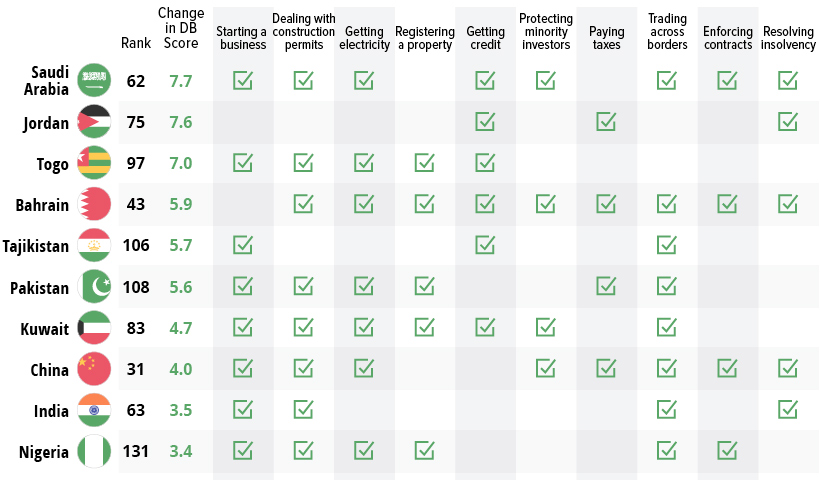
Saudi Arabia made the greatest improvement overall, adding 7.7 points to its score.
Bahrain also made improvements over the most number of factors (9). While Jordan showed improvement in the fewest factors (3), it showed the second highest jump in DB Score.
Gains Among Low-Income Countries
The DB 2020 study also shows that developing economies are making progress: it’s now cheaper than ever before to run a business in developing economies.
However, a significant disparity still remains when we consider the difference in business costs between high-income and low-income economies.
An entrepreneur starting a company in a low-income economy will spend about 50% of per capita income (PCI) to launch a venture, whereas an entrepreneur in a high-income economy spends only 4% PCI to accomplish the same task.
Put another way, entrepreneurs located in the bottom 50 economies spend an average six times more to open a new company as those in a high-income economy.
Entrepreneurship and Economic Growth
Generally, more entrepreneurs will enter a market where they can easily conduct business─adding more value to local economies.
While the rankings clearly illustrate the link between ease of doing business and economic growth, there are still significant barriers in place that not only deter entrepreneurship but also inhibit a relatively simple strategy for growth.
Markets
Ranked: The Largest U.S. Corporations by Number of Employees
We visualized the top U.S. companies by employees, revealing the massive scale of retailers like Walmart, Target, and Home Depot.
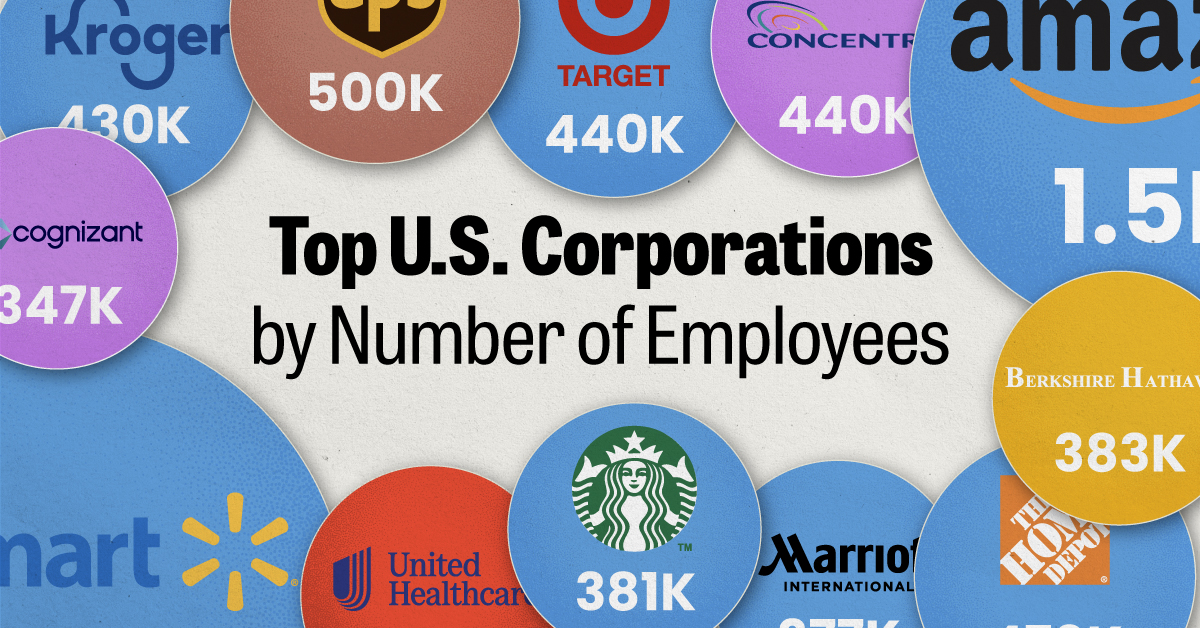
The Largest U.S. Corporations by Number of Employees
This was originally posted on our Voronoi app. Download the app for free on Apple or Android and discover incredible data-driven charts from a variety of trusted sources.
Revenue and profit are common measures for measuring the size of a business, but what about employee headcount?
To see how big companies have become from a human perspective, we’ve visualized the top U.S. companies by employees. These figures come from companiesmarketcap.com, and were accessed in March 2024. Note that this ranking includes publicly-traded companies only.
Data and Highlights
The data we used to create this list of largest U.S. corporations by number of employees can be found in the table below.
| Company | Sector | Number of Employees |
|---|---|---|
| Walmart | Consumer Staples | 2,100,000 |
| Amazon | Consumer Discretionary | 1,500,000 |
| UPS | Industrials | 500,000 |
| Home Depot | Consumer Discretionary | 470,000 |
| Concentrix | Information Technology | 440,000 |
| Target | Consumer Staples | 440,000 |
| Kroger | Consumer Staples | 430,000 |
| UnitedHealth | Health Care | 400,000 |
| Berkshire Hathaway | Financials | 383,000 |
| Starbucks | Consumer Discretionary | 381,000 |
| Marriott International | Consumer Discretionary | 377,000 |
| Cognizant | Information Technology | 346,600 |
Retail and Logistics Top the List
Companies like Walmart, Target, and Kroger have a massive headcount due to having many locations spread across the country, which require everything from cashiers to IT professionals.
Moving goods around the world is also highly labor intensive, explaining why UPS has half a million employees globally.
Below the Radar?
Two companies that rank among the largest U.S. corporations by employees which may be less familiar to the public include Concentrix and Cognizant. Both of these companies are B2B brands, meaning they primarily work with other companies rather than consumers. This contrasts with brands like Amazon or Home Depot, which are much more visible among average consumers.
A Note on Berkshire Hathaway
Warren Buffett’s company doesn’t directly employ 383,000 people. This headcount actually includes the employees of the firm’s many subsidiaries, such as GEICO (insurance), Dairy Queen (retail), and Duracell (batteries).
If you’re curious to see how Buffett’s empire has grown over the years, check out this animated graphic that visualizes the growth of Berkshire Hathaway’s portfolio from 1994 to 2022.
-

 Mining2 weeks ago
Mining2 weeks agoCharted: The Value Gap Between the Gold Price and Gold Miners
-

 Real Estate1 week ago
Real Estate1 week agoRanked: The Most Valuable Housing Markets in America
-

 Business1 week ago
Business1 week agoCharted: Big Four Market Share by S&P 500 Audits
-

 AI1 week ago
AI1 week agoThe Stock Performance of U.S. Chipmakers So Far in 2024
-

 Misc1 week ago
Misc1 week agoAlmost Every EV Stock is Down After Q1 2024
-

 Money2 weeks ago
Money2 weeks agoWhere Does One U.S. Tax Dollar Go?
-

 Green2 weeks ago
Green2 weeks agoRanked: Top Countries by Total Forest Loss Since 2001
-

 Real Estate2 weeks ago
Real Estate2 weeks agoVisualizing America’s Shortage of Affordable Homes

